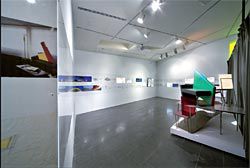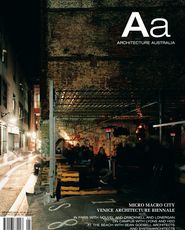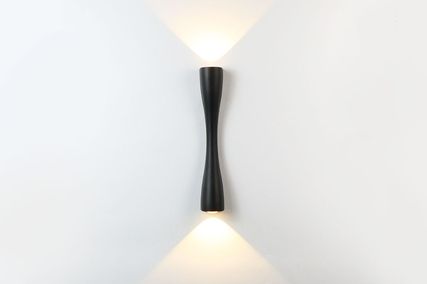PHOTOGRAPHY John Gollings
Review by Karen Burns
From coffeepots to freeway infrastructure, a recent exhibition charts the work of Denton Corker Marshall, diminutive and grand.


Overviews of the exhibition.
The recent Melbourne design festival drew together a diverse range of fields: graphic, industrial, fashion and, more modestly, architecture. In seeking to position design as a conscious activity of thinking and making artefacts and information systems, it threw up some insightful connections. For example, the small Espresso < Expressway exhibition explores the relationship between the architectural firm Denton Corker Marshall’s range of design activities in the fields of tableware, furniture, infrastructure (bridges and freeway work) and their buildings. Sketch drawings on yellow trace and presentation drawings and renderings document the non-architectural work and the wall text references particular buildings. However, the exhibition focused on design’s shared strategies of composition rather than pursuing how the firm’s architecture might be positioned among all of their design works. For the informed architectural viewer inferences can be drawn, while other spectators might simply enjoy viewing the material. And so it is a curiously partial show, with the ghost of the firm’s architecture hovering cited but unseen in the background.
In focusing on composition the exhibition offers much of interest to an architectural viewer. It returns us to that curious moment in the 1980s when certain architects and architecture schools were involved in a creative investigation of Russian constructivism. Architects as diverse as Rem Koolhaas, Howard Raggatt, Zaha Hadid and in another way Peter Corrigan were all pursuing some of the legacies of the Russian avant-garde. The Pompidou Centre held a large Paris–Moscow exhibition in 1979, the English magazine AD published a series of historical issues on Russian work from the 1920s and 30s, the Italian historian Manfredo Tafuri disinterred the architects for his avant-garde histories and in Koolhaas’s delirious dream of New York, the Russian constructivists reached Manhattan some forty years after departing their Soviet shores. Denton Corker Marshall, to my mind, is the only local firm who engaged (like Koolhaas, Hadid and the AA School in London) with such strong appropriative strategies. Or to formulate the question of creative research in another way, these architects reworked the graphic, compositional and spatial elements of the Russian projects.
This interest sets Denton Corker Marshall apart from many of their Australian peers.
It established them within a global network of reception. Since the work originated in Russia decades before, Denton Corker Marshall in Melbourne formed a constellation with the east coast of North America, London, the Netherlands, Paris and Venice in creatively working with source material. There is no question here of provincial lag. I think I knew all this at the time, but the exhibition, some twenty years after the moment, sharpens the historical perspective.
Insights stem from the presentation of the National Gallery of Victoria-commissioned tableware design as a plan drawing.
Russian constructivist work was, theoretically, scaleless; the emphasis lay on the relations between elements. Other architects working for Alessi in the 1980s, such as Michael Graves and Aldo Rossi, also scaled up their works – Graves lifting an element from his Portland Building, Rossi enlarging the coffeepot potential of his pavilion-like buildings. However, viewing the Denton Corker Marshall exhibition clarifies the differences in their method of working. Denton Corker Marshall magnify components of their architectural work as well, but the sense of an overriding relationship between elements abides.
Thus, like other architects working with the residue of constructivism, they investigate the strategies of object and field.
This is most notable in their table centrepiece, which retains the tension of the horizontal flatbed field and the vertical arrangement of elements/objects. Like the Russian schemes, individual components tend to be linear, signalling an idea of each part as a plane extending infinitely into space. This technique formulates a sense of space as continuous and dynamic, one founded in contrast – against the solidity of the ground plane and the horizontal volumes, which seem to pin and temporarily hold the extended spatial flight of the projects.
Seeing Denton Corker Marshall’s miniature design objects, or the presentation renderings where large-scale infrastructure projects can be viewed as one object, offers an insight due to the scale, rather like viewing a constructivist drawing or object. We are not as distracted by the process of navigating a large building.
Interesting strategies must be invented to resolve the problem of enlarging a small composition into a building. The constructivist legacy is reworked. For example, the focus on a compositional linear arrangement of parts is deftly reformulated into the extended circulation paths of Denton Corker Marshall’s large enterprises such as the Melbourne Museum and the Convention Centre. The Russian focus on individual elements is adapted to the disposition of a complex programme.
Each component can hold a separate programmatic requirement. The notion of a building as a series of planes extending into space becomes a strategy for engaging with the larger spatial field of the city.
The exhibition explores how forms, composition and organization may be shared between domains of design activity.
It also reminds us of the creative possibilities and difficulties of translation.
Many years ago, during the series of conversations that would be published as The Charlottesville Tapes (1985), Robert Stern remarked on Koolhaas’s debt to the constructivists and the problems posed by their compositional technique. Stern complained of the lack of surface detail when the Soviet miniature constellations are enlarged to built form. With some insight and steady nastiness, he complained that this strategy relied on “the diminished piece of furniture to make the place”. He is right. It takes some negotiation to resolve this particular problem.
KAREN BURNS IS AN ARCHITECTURAL HISTORIAN, THEORIST AND CRITIC BASED IN MELBOURNE.















